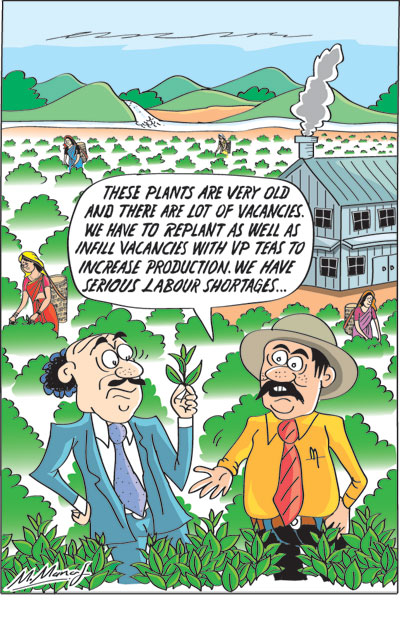Columns
Tea: Higher productivity would enhance exports and improve trade balance
View(s):The neglect of export crop agriculture has been one of the serious setbacks to the economy in recent decades. This is especially so of tea, the country’s main agricultural export.
 Higher productivity on tea plantations is vital to increase production and enhance the exportable surplus of tea to increase export earnings and reduce the country’s trade deficit.
Higher productivity on tea plantations is vital to increase production and enhance the exportable surplus of tea to increase export earnings and reduce the country’s trade deficit.
Overview
Declining agricultural export earnings has been one of the serious weaknesses in exports. The main causes for this is the decreased production and export surpluses of coconut, tea and rubber. There has also hardly been any increase in spice crops. Cashew is perhaps one of the few increases in agricultural exports. Sea food exports has been a significant exception to this.
Export surpluses
The export surpluses of all three principal agricultural exports have declined. Over time plantation agriculture was neglected owing to high taxation, threat of nationalisation, state takeover of estates in 1974, and mismanagement of estates by state enterprises. Consequently, tea production on estates declined and estates incurred large losses.
Smallholdings
Tea exports would have plunged to low levels if not for the expansion of smallholder tea production. Smallholder tea production is around two thirds of total production and productivity is about twice that of estates.
 Estates
Estates
Estate tea has a high proportion of low productive senile tea. These have to be replanted with vegetative propagated (VP) teas. However, there is no incentive for uprooting senile tea plots and replanting. Research funding for tea is grossly inadequate and the once prestigious Tea Research Institute (TRI) is weak.
Long term
Increasing tea production cannot be achieved in a short period of time. There has to be a programme of replanting that would increase productivity over time. Incentives for replanting is crucial to achieve an optimum level of replanting with high yielding VP teas.
Misconception
A serious misconception in the minds of many is that tea has diminished its important role in exports after the growth of manufactured exports. It is often said that manufactured exports are far more important than agricultural exports as they account for about 75 percent of merchandise exports, while agricultural exports account for only about 25 percent of total export earnings. Tea exports that were the main export till the 1980’s are about 20 percent of all merchandise exports.
Recent exports
In 2017-2019 before the COVID-19 pandemic engulfed the world economy, annual tea exports averaged around US$ 1.5 billion, while manufactured exports contributed between US$ eight to nine billion. In 2017-2019, agricultural exports accounted for about 20 to 25 percent of merchandise exports, while manufactured exports contributed over 75 percent of exports. All agricultural exports amounted to about US$ 2.5 billion a year.
Misleading
However this statistic is somewhat misleading of the relative importance of the two categories of exports as their domestic value addition is very different. Most manufactured exports have a high import content of about 65 to 70 percent in comparison to agricultural exports that have a high domestic value addition and low import content of about 30 percent. This is so with the country’s main agricultural export of tea as well. Other agricultural exports have even higher domestic value addition.
Tea exports
In the three years 2017-2019 tea exports amounted to a little less than US$ 1.5 billion per year, while all manufactured exports earned about US$ nine billion. In terms of domestic value addition, manufactured exports earned about US$ six billion, while tea contributed a net value addition of about US$ one billion. There is no doubt that manufactured exports are more important, but their relative importance is less than the figures suggest.
When viewed in this light, the importance of agricultural and tea exports to the trade balance is more important than suggested by the export earnings. It is a significant and valuable export earner that has a potential for increasing. Admittedly, all manufactured exports contributed more than tea even in terms of net foreign earnings.
Salient point
The salient issue is that increased tea exports could contribute significantly to export earnings. It is not an argument for one category of exports rather than another.
Tea production
The main constraint to increasing tea exports is not international demand. Sri Lanka’s exports of orthodox tea is one half of world exports. It is the exportable surplus or the amount of tea that is produced in the country. About 25 percent of the country’s tea production is domestically consumed. For instance, in 2018 tea production amounted to 303 kilograms of which 212 million kilograms or 67 percent was exported.
Constraint
The main reason for the tea export surplus not increasing has been the neglect of the plantations over the last five decades. In fact tea exports would have dipped drastically if not for the growth of tea smallholdings that account for the bulk of tea production in the country. This fact too is nor often known or recognised.
Small holdings
Tea smallholdings now account for about 70 percent of tea production, while plantations accounted for only about 30 percent of tea produced in the country. Productivity on small holdings is about twice that on estates. The average yield on estates is 1100 kilograms per hectare, while it is 1600 kilograms on small holdings.
Reasons
There are agronomic factors for this divergence such as more sunlight, more fertile virgin soils. Labour productivity too is higher.
On the other hand, the plantations have poor soils after over a century of cultivation, tea bushes are senile, vacancies are high and higher yielding Vegetative Propagated (VP) tea extents are inadequate. Labour shortages are also a serious constraining factor.
Conclusion
The revival of tea plantations cannot be achieved by a quick fix solution. There has to be a plan for resuscitating tea plantations with incentives for replanting and infilling of vacancies. The Tea Research Institute (TRI) has to be adequately funded to attract scientists of excellence as in the past. Mechanisation and improved techniques should attempt to resolve labour shortages.
Increased production by enhanced productivity on the plantations by increasing the country’s exportable surplus of tea could enhance the country’s export earnings significantly. The productivity of tea plantations has to be enhanced to their full potential. Are we capable of implementing a long term programme to increase productivity of the 150-year old tea plantations?


Leave a Reply
Post Comment